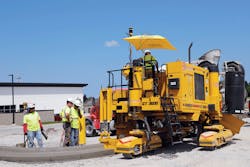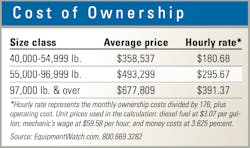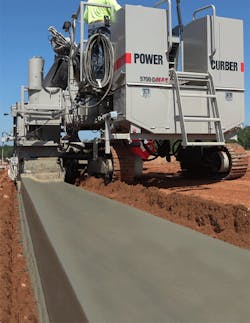Slipform Pavers Get Simple for Stringless Technology
The market for slipform pavers is good, as manufacturers are reading the skilled labor shortage and responding with easier-to-use pavers and curb-and-gutter machines—they’re also accommodating users’ big shift toward technology and stringless 3D machine control operation.
“It’s all been very positive this year,” says Fred Bryan, VP of sales, Power Curber Companies (Power Curber and Power Paver brands). “There’s been a lot of residential development and Interstate barrier work.”
Tim Nash, director, concrete products, for Wirtgen, agrees.
“Generally it’s strong,” Nash says. “We’ve got contractors, a lot of them, with a really healthy backlog going into 2020 and beyond. I wouldn’t say that it’s up, but it’s still strong, and flat is how I would describe that—a good flat.”
How housing affects slipform pavers
Bryan sees two different areas of growth for slipform pavers. “The biggest thing we’ve seen is more residential development on the domestic part; on the international part it’s primarily road paving machines. We’ve had a very good year with our paving products, and it’s been both residential and infrastructure improvement projects. But, primarily of the two, we’ve seen more of the residential growth this year than we’ve seen anywhere else.”
A recent small downturn in housing doesn’t seem to concern Nash. “Even with housing down a little bit, if we got specific, we could break that down into two different areas we deal with: What we would call the curb and gutter or the offset market, and the road paving or mainline paving market,” Nash says. “I would say the same about both, even though housing starts are down a little bit, it’s still a lot of activity. There’s still building going on, and the same for the roads. There’s still building with roads and airports, and it continues to be strong as well. We see that still going into 2020.”
“Domestic demand has been steady, but would be aided by a long-term infrastructure bill, of course,” says Kevin Klein, VP of engineering and research and development for GOMACO. “Internationally, we’re also seeing a lot of activity.”
Contractors are looking to slipform pavers that is more compact and versatile, OEMs tell Construction Equipment. “With a lot of smaller projects, we’re seeing a lot of curb and gutter work, as well as sidewalks with our pavers,” Bryan says. “Our smaller pavers are very good residential pavers, so we’ve had good success selling those.
“Contractors are looking for something that is easy to operate—something that is very compact, because you’ve got to transport from one site to another—and something where it’s very easy to change widths—to go from one width to another,” Bryan says. “So it’s really all about making it easy to move or change sizes with the equipment.
“We find that one of the biggest challenges in the market is maintaining operators,” Bryan continues. “Keeping good trained staff is difficult. The easier you can make it for the machines to be able to operate, the better off you are with your products. So we really concentrate on simple science—the machines are as complex as any technology you would want, but you have to make them very simple to operate and maintain.”
Slipform pavers increase productivity
Nash says his customers are looking for increased production and the ability to move and adapt.
“For your curb and gutter guys and generally the housing and the commercial parking lot markets, what they’re looking for is increased production,” Nash says. “In a lot of these jobs, the machines need to be moved around a bunch, so what they’re looking for is high productivity, and quality is the ante.
“In general, they’re looking for the ability to move these machines around with as little time in transport or maneuvering from one part of the job to another, or from one job to another job, keeping that downtime down and paving time up,” Nash says.
Manufacturers also note a big shift toward stringless paving work. “One of the significant trends, and I’ve been saying this for decades now, but it’s finally starting to take place, is the automation and removal of the traditional stringlines and going with 3D or stringless solutions to control the slipform pavers,” Nash says. “It is definitely, finally, starting to significantly increase. It’s taken a while, because it’s a big deal for a lot of guys to go from what they can see, feel and touch, with a stringline to models or some other form of stringless control.”
Nash points out that the technology’s been around for some time, and resistance has played a part in the delay.
“Change is hard, and when you’ve been controlling your job sites by a physical guidewire and you go to something you can’t see, it’s a big jump,” he says. “So there’s some resistance to technology, there’s some resistance to change in general, and there’s also been a cost component to that, as well. But people are now making that jump and they’re not looking back.”
Results and economics are overcoming concerns about initial cost and driving the decision toward stringless.
“It’s a pretty big investment and there’s a lot of wait and see,” Nash says. “But now that there are enough of these systems out there, people are understanding that though it’s a little intimidating, the benefits are finally being seen to outweigh the potential risk. Also, there’s the competitive posture; the guys who make that jump first and do it successfully, they’re changing the economics and their competitiveness in the marketplace. Now people are seeing that they can and will be left behind if they don’t make that move.”
Those who aren’t using stringless seem to know they will need to embrace the technology in the future.
“We’re either getting people who are going directly into [stringless] or are wanting a machine that’s set up to go to it in the future,” Power Curber’s Bryan says. “That’s probably one of the bigger trends we’ve seen, and there’s been a big transition to it from one year to another. I can tell you this year we’ve seen probably a 70-percent increase in going to that technology in the new sales than what we saw with last year’s.”
GOMACO’s Klein says stringless is going to continue its hot streak. “GOMACO introduced 3D stringless paving 20 years ago with the first city street,” he says. “3D control is becoming the overwhelming choice as the savings outweigh any additional upfront costs as control systems become easier to operate.”
Once new slipform pavers are in the fleet, it’s important to keep operating costs in line. Stringless technology can definitely play a part. “People are looking at how much more they can make at the end of the day, because if they have stringless technology and they have a better day than normal, they can just continue on with their models that they already have programmed in,” Bryan says.
“On a stringline, if they had not already set that up for extra time or extra distance, at the end of the day you can’t just get a crew out there and put up stringlines real quick,” Bryan says. “There’s also some difference in manpower usage for setting up stringline versus using 3D systems, so that’s another reason I think people are looking at [stringline to keep costs down].”
Wirtgen’s Nash takes a macro view.
“Clearly there are differences on how pavers are designed and manufactured that can speak to improved operations, reduced costs, and maximized uptime, and that’s something that managers need to look at closely,” Nash says. “They need to focus on four key areas; frame design, mold design, the attachments, and the control systems that tie that all in together.
“And generally speaking, the ‘oldies’ are still relevant,” Nash says. “It sounds very simple and basic but it’s true; managers from the top down need to be talking to the paving crews about maintenance—they need to keep the machines clean at the end of every day, adhering to the recommendations for those maintenance programs, and taking full advantage of manufacturers’ winterization programs.”
Nash says some manufacturers offer winterization programs for free. “They come take a look at the machines and make sure that when the snow melts, you’ve got as much uptime as possible. Then during those down times, or available times, focus on getting the guys that are around the paver and on the paver to the manufacturer’s training programs. This is key.
“So often, guys get pulled onto a machine without any real training, and they expect to learn it on the go, and that often leads to downtime for a range of different reasons,” Nash says.
“It’s absolutely critical to take advantage of manufacturers’ training,” says Klein. “We have GOMACO University, which offers a complete range of courses covering our full range of concrete paving equipment. It’s invaluable what those students learn from our experienced instructors, as well as from each other.”



